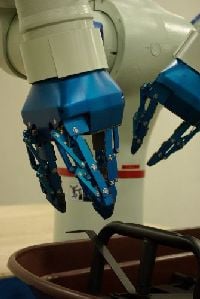Robotic Kitting


When I was young, I was doing hardwood flooring with my brother. I would prepare the pieces of wood on the floor so he could continuously nail them together without stopping. The philosophy of robotic kitting is the same: Have some robot(s) prepare the material in kits so other robot(s) run at full capacity utilizing the kitted parts.
Sometimes on assembly lines, feeding parts to robots is more complicated than the actual operation that the robot does with the part. Think bowl feeders, bin picking and manual feeding: all of these present productivity and cost challenges.
Let's take an assembly line in an automotive plant for example. Imagine that instead of having parts fed at the side of the line, you have a kitting station at the beginning of the line that fills racks with the appropriate parts. Then, this rack of parts travels along the line with the body of the automobile as it gets assembled.
What are the benefits of robotic kitting?
The main reason kitting is so interesting is because it makes the configuration process of a manufactured good more efficient. The number of different versions of a product grows exponentially with the number of options that you have. By centralizing the configuration part (think Kiva Systems), you can make it more efficient. You can also save on floor space.
See the robotic kitting video below that we did with Robotiq Adaptive Grippers on Motoman's Dual Arm robot.
If you cannot see the video please click here






Leave a comment